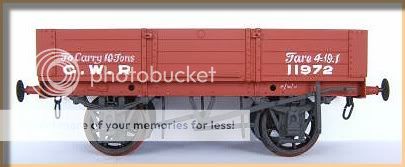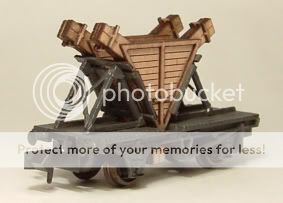History of GWR
Posted
#7334
(In Topic #813)
Full Member
The estamated price for this project was £2,800,000. The first row started when Brunel wanted the size of the line changed. He felt the line size of 7feet 01/4inch would be better suited for speed and comfort instead of the standard 4feet 81/2inch, needless to say he had his way. He had the job split into 2 areas. The first area was Bristol and Bath and at the same time Reading to London, eventually reducing the gap between them. At the same time grand stations where built, these where Bristol-Temple Meads and London – Paddington, also other numerous other buildings where built at the same time, this included a carrage and locomotive works in Swindon. All this began in 1836.
By 1841 the whole London To Bristol line was complete and nicknamed Brunel’s billardtable. The total cost was £6,500,000, bit over budget hey. Swindon went into history by having the first refreshment rooms for the public and a stop of 10minutes was given for them to use them. Although before a curse was on the GWR as this stop meant the trains could not speed up, until May 1845 the GWR intruduced a express service to Exeter without any stops. Which meant the refreshment building was not used and so they took the GWR to court, the company lost their case.
By 1848 250miles of broad gauge track was laid, but unfortionatly they ran into trouble at Gloucester where the broad gauge met the standard gauge track from the north. So in 1846 another Act was passed preventing GWR from building anymore broad band track from this point. So a compromise was agreed, GWR built a third rail, enabling the broad gauge trains to and standard gauge trains to use the same track. Clever hey.
GWR had all its loco’s running on coal and so this made them suffer regarding paymeant. Coal companys knew they needed coal to run and so charged the earth but GWR then went and started their own coal mining company in 1878, these where in Blaenavon, Wales. Eventually this started to pay and over 2500 men where employed here and provided the company with cheaper coal.
In later years the tracks where refitted to the standard gauge and sadly this gave way to the biggest withdrawn fleet of steam loco’s in any one place until BR ended all steam working. Also thousands of carriage’s and wagons waited to be scrapped or converted to standard gauge. The last of all this refit was in 1892.
Well this is the start guys, if you find it boring sorry.
The next part will be about the Loco’s, wagons and goods carried. Any feed back welcome.
Phill
Posted
Legacy Member
Posted
Full Member
As it began to be built the GWR soon realised that due to things happening along the line they needed to have some way to restore order, so the Great Western Railway Police was formed. At first the strength was 1 inspector and 33 constables. They covered the 24 ½ mile stretch from Paddington to Maidenhead. They realised that when construction was complete the Police where still needed, as the whole line had to be patrolled. The reason why GWR formed their own police force was due to the fact of the size of the line. Their was not enough local police to do it and so they formed their own. Now this strange statistic is what Brunel told a Parliamentary Select Committee that there was a average of 1 ½ policeman per mile along the line between London and Bristol line, including those on stations. Now I have a vision of half a body walking the his patch. :D Well from the original 38 men it soon rose to 170. So much growth that the line was split into divisions and so separate inspectors where appointed to take charge of the different divisions. There was 5 divisions, London, Bristol, Birmingham, Cardiff and Docks. Each was then divided into 24 districts. Much later when the men who worked one man posts where all made up to inspectors. This was thought to enable the men to be more responsible and honest. Even the GWR police themselves where not trusted back then.
The uniform consisted of a dress coat, and a top hat.
 The inspectors where spotted by a 1 1/4inch red stripe down the side of the trousers. The top hat was soon change to a more comfy hat in 1859. They also carried a 18inch wooden staff. Decorated in gold paint and a crown and the letters GWR. Inspectors carried their warrant on a parchment rolled up in a staff consisting of a short hollow brass and ebony tube with a removable cap in the shape of a crown.
The inspectors where spotted by a 1 1/4inch red stripe down the side of the trousers. The top hat was soon change to a more comfy hat in 1859. They also carried a 18inch wooden staff. Decorated in gold paint and a crown and the letters GWR. Inspectors carried their warrant on a parchment rolled up in a staff consisting of a short hollow brass and ebony tube with a removable cap in the shape of a crown.What they did.
The police did everything in the early days. They patrolled the rails, which is I think is well know but did you know they performed allot more duties than folks think. They ranged from, track patrol, signalling, stopping trains, tunnel duties i.e., stopping a train going through if it was only a one track section. Looking after stations, letting passengers the times of trains, infact everything to do with running a railway they did it. Some pics of the jobs they did.



A interesting bit of a fact is this. In 1845 the railway telegraph was installed and infact due to this, when a murder took place in Slough the person who did it was caught at the station, becoming the first murderer to be caught by telegraph.
The policeman would receive a 40shilling fine if they did not show their warrant card upon request. In later years in was decided to merge the GWR with other railway police forces. The only difference between the uniforms they had to wear when the change came was the badge. Only the GWR police could wear the queens crown in the badge, as this was granted only to the GWR, due to the work they did, they often escorted her along the railway when she made her train journey from Slough to Paddington. She later used the nearby Windsor Central Station which was adjacent to the castle. A special waiting room was built Many years later it became the HQ of the South Western Area of the British Transport Police, a descendant of the GWR Police. Also in 1882 the queens live was in danger when a man tried to shoot her at the station but fortunately he was stopped.
In 1945 a government came to power and ordered the nationalisation of the railways and so the Transport act 1947 became effective 1 January 1948 and in the following year all Police would become one Force and named British Transport Police, the ones you see today. Thus the final Great Railway was no more the most powerful as it once was.
Hope you have enjoyed this, feel free to post any comments. The pics where ok and i did send a email to confirm it was.
Phill
Posted
Full Member
In This year the GWR where greatly losing money due to the competition in town areas , this was due to horse drawn bus’s and electric streetcar trams. Yes even back then they had competition within the transport industry.
So GWR had to sink or swim. So they introduced rail-steam cars( Picture coutesy of John Daniel on the GWR Archieves Site)

This was produced so they had more frequent services of small passenger coach's that could be provided on both suburban and country lines. The trials took place in 1903 with a Dugald Drummond rail motor which he had designed for the .S.WR/L.B.S.C.R. East Southsea service. As a result of the success of the trials it came into service in October 1903.
They featured an open saloon type interior with seats on either side of a central aisle, however only one class was catered for and some of them had a section partitioned off for non-smokers. At one end of the car was the driving bogie whilst the other end carried a eight foot bolster bogie which, for the first time replace the Dean suspension bogie. The vertical boiler was mounted on the underframe of the driving bogie. The passengers entered and exited at the trailing end of the carrage and there was also at both ends a position for the driver to stand whilst driving the car forwards or backwards.
Two cars operated between Chalford and Stonehouse and at level crossings steps where lowered to let passengers on and off. Blimey you imagine stopping at a level crossing today :shock: . However they soon realised this was a safety issue, (yep in 1903 they did think of safety, phew thank goodness :) . So much so they built small platforms called Halts for them to get off and made them easy to get to the main road from.
This mode of transport became so popular that before long housing estates where built next to the halts and thus these can be still be seen and some are used still today.So if your in the GWR region have a look there may be one near your housing estate.So big was this form of travel that they attach what they called a trailer car to the steam car. This ultimately led to their demise as the engines where not big enough to carry all the passengers and a trailer car full of passengers and was eventually replaced by Auto-Trains in 1905. Also a ordinary tank engine such as a Wolverhampton class 517 0-4-2 was fitted with controls which could be extended if required. It had sufficient power to pull 4 coach’s. two in the front and two at the back. It could also go at a faster speed of 30mph which is what the steam cars did.
I shall endeavour to find out about the auto trains and do a report on them.
TTFN
Phill Collins.
Posted
Full Member
Aparently the first early wagons in GWR where painted in red before changing into grey in later years. No one knows the actually date of when this red was done but not too worry i shall research and let you know. Also a strange wagon only made by GWR to transport the old 3 propellor planes blades.



I shall again reasearch and report back.
By the way once i have felt enough research on GWR is enough i shall research another railway. Would anyone like to suggest one please.
Phill
1 guest and 0 members have just viewed this.

